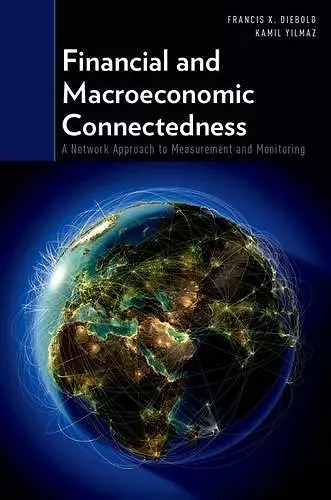Financial and Macroeconomic Connectedness
A Network Approach to Measurement and Monitoring
Kamil Yilmaz author Francis X Diebold author
Format:Paperback
Publisher:Oxford University Press Inc
Published:2nd Apr '15
Currently unavailable, and unfortunately no date known when it will be back

Connections among different assets, asset classes, portfolios, and the stocks of individual institutions are critical in examining financial markets. Interest in financial markets implies interest in underlying macroeconomic fundamentals. In Financial and Macroeconomic Connectedness, Frank Diebold and Kamil Yilmaz propose a simple framework for defining, measuring, and monitoring connectedness, which is central to finance and macroeconomics. These measures of connectedness are theoretically rigorous yet empirically relevant. The approach to connectedness proposed by the authors is intimately related to the familiar econometric notion of variance decomposition. The full set of variance decompositions from vector auto-regressions produces the core of the 'connectedness table.' The connectedness table makes clear how one can begin with the most disaggregated pair-wise directional connectedness measures and aggregate them in various ways to obtain total connectedness measures. The authors also show that variance decompositions define weighted, directed networks, so that these proposed connectedness measures are intimately related to key measures of connectedness used in the network literature. After describing their methods in the first part of the book, the authors proceed to characterize daily return and volatility connectedness across major asset (stock, bond, foreign exchange and commodity) markets as well as the financial institutions within the U.S. and across countries since late 1990s. These specific measures of volatility connectedness show that stock markets played a critical role in spreading the volatility shocks from the U.S. to other countries. Furthermore, while the return connectedness across stock markets increased gradually over time the volatility connectedness measures were subject to significant jumps during major crisis events. This book examines not only financial connectedness, but also real fundamental connectedness. In particular, the authors show that global business cycle connectedness is economically significant and time-varying, that the U.S. has disproportionately high connectedness to others, and that pairwise country connectedness is inversely related to bilateral trade surpluses.
Diebold and Yilmaz's timely book develops powerful new network tools for understanding the inter-dependence of risks in large-scale financial systems. These tools shed important new light on past financial crises and will fill an important gap in the monitoring of systemic risk going forward. * Peter Christoffersen, Professor of Finance, Rotman School of Management, University of Toronto. *
The aftermath of the Lehman bankruptcy revealed that economists lacked understanding of the linkages within the financial industry and across the different sectors of the economy. The book by Frank Diebold and Kamil Yilmaz has many fresh ideas and new tools to study this very important topic. It is a must-read for anybody interested in this burgeoning area of research. * Eric Ghysels, Bernstein Distinguished Professor of Economics and Professor of Finance, University of North Carolina, Chapel Hill *
We live in a highly integrated world economy with much stronger cross-border connections today than any other time in history. We need to have a better grasp of these connections as they are now at the heart of everyday macroeconomics and finance. Diebold and Yilmaz provide a masterful framework that greatly enhances our understanding of these connections. They also open new research avenues by showing practical applications of their framework in different contexts. And all of these make their book a classical reference on the topic. * Ayhan Kose, Director, Development Prospects Group, The World Bank *
ISBN: 9780199338306
Dimensions: 155mm x 231mm x 15mm
Weight: 408g
288 pages